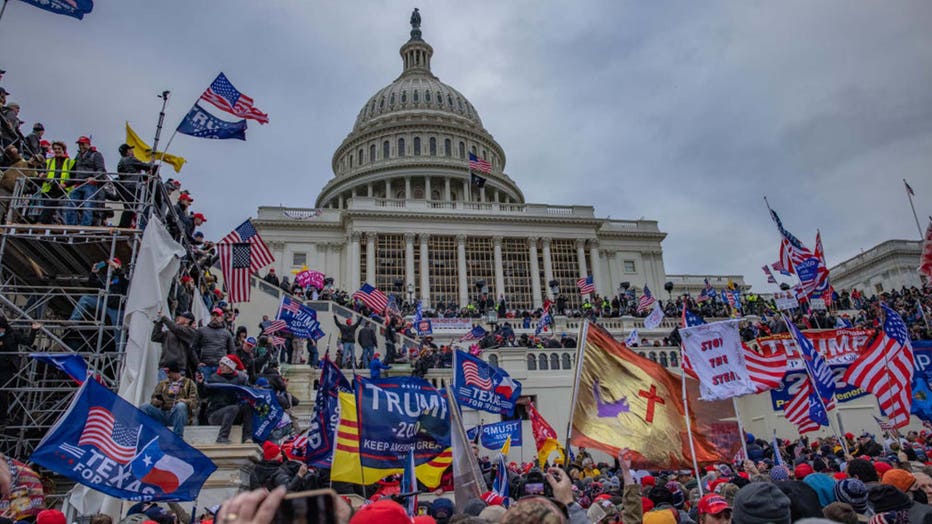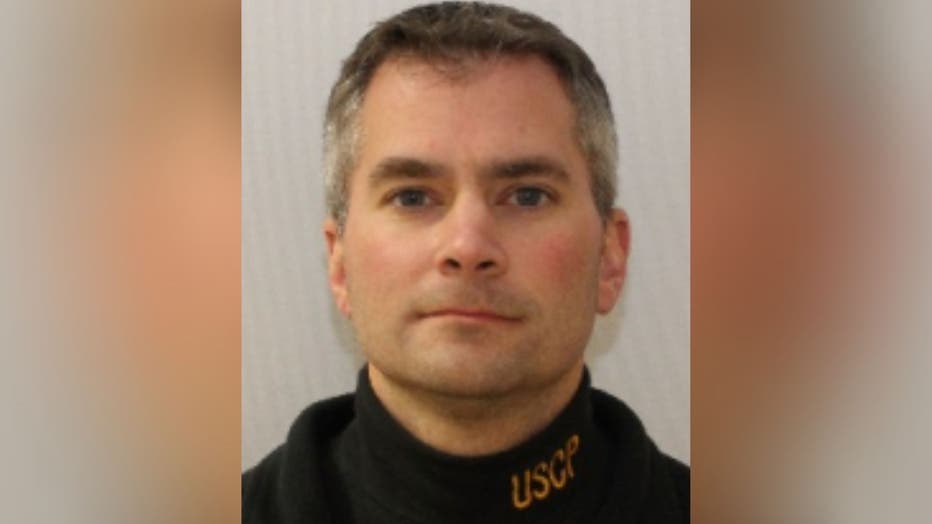Capitol Riot: A look back on year since January 6 insurrection

Looking back on Jan. 6 Capitol Riot
January 6 marks one year since the U.S. Capitol riot, when pro-Donald Trump rioters charged the steps as Congress began counting the Electoral College votes.
WASHINGTON (FOX 5 DC) - January 6 marks one year since the U.S. Capitol riot, when pro-Donald Trump rioters charged the steps as Congress began counting the Electoral College votes.
The ensuing chaos prompted law enforcement and the National Guard to mobilize in D.C. as a response.

Capitol Riot: President Biden marks one year since January 6 insurrection
President Biden and Vice President Harris addressed the nation Thursday to mark one year since the January 6 U.S. Capitol insurrection.
Neighboring Virginia and Maryland sent hundreds of State Troopers and National Guard members to the nation's capital as the crisis escalated.
Shortly after crowds surged around the building, Capitol police sent out an alert:
All buildings within the Capitol Complex, Capitol: Due to an external security threat located on the West Front of the U.S. Capitol Building, no entry or exit is permitted at this time. You may move throughout the building(s) but stay away from exterior windows and doors. If you are outside, seek cover.

FILE - Rioters storm the United States Capitol building on Jan. 6. (Evelyn Hockstein/For The Washington Post via Getty Images)
RELATED: Capitol Riot: Events planned to mark January 6 anniversary
Both chambers abruptly went into recess amid the chaos.
Lawmakers were given gas masks as police tried to control the situation inside the Capitol.
The surge occurred after thousands poured into the nation’s capital to support Trump, and to protest the results of the 2020 election, which Joe Biden won.
Skirmishes erupted outside in the very spot where president-elect Biden was eventually inaugurated two weeks later.
RELATED: Biden, Harris to deliver remarks on anniversary of Jan. 6 Capitol riot
According to D.C. police officials, protesters deployed `chemical irritants on police' to gain access to US Capitol.
Protesters tore down metal barricades at the bottom of the Capitol's steps and were met by officers in riot gear. Some tried to push past the officers who held shields and officers could be seen firing pepper spray into the crowd to keep them back.
Some in the crowd were shouting "traitors" as officers tried to keep them back.
PHOTOS FROM JANUARY 6, 2021
Take a look back at photos from the Capitol riot in D.C.
TIMELINE OF THE CAPITOL RIOT
On the eve of Trump’s rally Jan. 6 near the White House, the first 255 National Guard troops arrived in the district, and Mayor Muriel Bowser confirmed in a letter to the administration that no other military support was needed.
By the morning of Jan. 6, crowds started gathering at the Ellipse before Trump’s speech. According to the Pentagon’s plans, the acting defense secretary would only be notified if the crowd swelled beyond 20,000.
READ MORE: National Guard deploying at least 10K troops to DC
Before long it was clear that the crowd was far more in control of events than the troops and law enforcement there to maintain order.
Trump, just before noon, was giving his speech and he told supporters to march to the Capitol. The crowd at the rally was at least 10,000. By 1:15 p.m., the procession was well on its way there.
As protesters reached the Capitol grounds, some immediately became violent, busting through weak police barriers in front of the building and beating up officers who stood in their way.
At 1:49 p.m., as the violence escalated, then- Capitol Police Chief Steven Sund called Maj. Gen. William Walker, commanding general of the D.C. National Guard, to request assistance.
Sund’s voice was "cracking with emotion," Walker later told a Senate committee. Walker immediately called Army leaders to inform them of the request.
Twenty minutes later, around 2:10 p.m., the first rioters were beginning to break through the doors and windows of the Senate. They then started a march through the marbled halls in search of the lawmakers who were counting the electoral votes. Alarms inside the building announced a lockdown.
Sund frantically called Walker again and asked for at least 200 guard members "and to send more if they are available."
But even with the advance Cabinet-level preparation, no help was immediately on the way.
Over the next 20 minutes, as senators ran to safety and the rioters broke into the chamber and rifled through their desks, Army Secretary McCarthy spoke with the mayor and Pentagon leaders about Sund’s request.
On the Pentagon’s third floor E Ring, senior Army leaders were huddled around the phone for what they described as a "panicked" call from the D.C. Guard. As the gravity of the situation became clear, McCarthy bolted from the meeting, sprinting down the hall to Miller’s office and breaking into a meeting.
As minutes ticked by, rioters breached additional entrances in the Capitol and made their way to the House. They broke glass in doors that led to the chamber and tried to gain entry as a group of lawmakers was still trapped inside.
At 2:25 p.m., McCarthy told his staff to prepare to move the emergency reaction force to the Capitol. The force could be ready to move in 20 minutes.
At 2:44 p.m., Trump supporter Ashli Babbitt was fatally shot by a Capitol Police officer as she tried to climb through a window that led to the House floor.
Shortly after 3 p.m., McCarthy provided "verbal approval" of the activation of 1,100 National Guard troops to support the D.C. police and the development of a plan for the troops’ deployment duties, locations and unit sizes.
Minutes later the Guard’s emergency reaction force left Joint Base Andrews for the D.C. Armory. There, they would prepare to head to the Capitol once Miller, the acting defense secretary, gave final approval.
Meanwhile, the Joint Staff set up a video teleconference call that stayed open until about 10 p.m. that night, allowing staff to communicate any updates quickly to military leaders.
At 3:19 p.m., Pelosi and Schumer were calling the Pentagon for help and were told the National Guard had been approved.
But military and law enforcement leaders struggled over the next 90 minutes to execute the plan as the Army and Guard called all troops in from their checkpoints, issued them new gear, laid out a new plan for their mission and briefed them on their duties.
The Guard troops had been prepared only for traffic duties. Army leaders argued that sending them into a volatile combat situation required additional instruction to keep both them and the public safe.
By 3:37 p.m., the Pentagon sent its own security forces to guard the homes of defense leaders. No troops had yet reached the Capitol.
By 3:44 p.m., the congressional leaders escalated their pleas.
"Tell POTUS to tweet everyone should leave," Schumer implored the officials, using the acronym for the President of the United States. House Majority Leader Steny Hoyer, D-Md., asked about calling up active duty military.
At 3:48 p.m., frustrated that the D.C. Guard hadn’t fully developed a plan to link up with police, the Army secretary dashed from the Pentagon to D.C. police headquarters to help coordinate with law enforcement.
Trump broke his silence at 4:17 p.m., tweeting to his followers to "go home and go in peace."
By about 4:30 p.m., the military plan was finalized and Walker had approval to send the Guard to the Capitol. The reports of state capitals breached in other places turned out to be bogus.
At about 4:40 p.m. Pelosi and Schumer were again on the phone with Milley and the Pentagon leadership, asking Miller to secure the perimeter.
Download the FOX 5 DC News App for Local Breaking News and Weather
But the acrimony was becoming obvious.
The congressional leadership on the call "accuses the National Security apparatus of knowing that protestors planned to conduct an assault on the Capitol," the timeline said.
The call lasts 30 minutes. Pelosi’s spokesman acknowledges there was a brief discussion of the obvious intelligence failures that led to the insurrection.
It would be another hour before the first contingent of 155 Guard members were at the Capitol. Dressed in riot gear, they began arriving at 5:20 p.m.
They started moving out the rioters, but there were few, if any, arrests. by police.
At 8 p.m. the Capitol was declared secure.
READ MORE: DC mayor declares public emergency for 15 days following Capitol riots
CAPITOL RIOT DEATHS
Six people died as a result of the riot, in which a mob departed a rally at Freedom Plaza featuring former President Donald Trump to storm the U.S. Capitol.
On Jan. 6, Ashli Babbitt joined the crowd of people that gathered on the U.S. Capitol grounds to protest the results of the 2020 presidential election.

Ashli Babbitt
The investigation revealed that she was among a mob of people that entered the Capitol building and gained access to a hallway outside "Speaker’s Lobby," which leads to the Chamber of the U.S. House of Representatives.
Babbitt, a 14-year Air Force veteran from San Diego, was shot by the officer as she attempted to climb through a broken window of a door that led to the Speaker’s Lobby outside of the House chamber. She was rushed to Washington Hospital Center in critical condition and later died from her wounds.
Many have characterized Babbitt's death as unjust, and in June her husband appeared on "Tucker Carlson Tonight," saying the media's characterization of his wife "sickened" him.
The officer who shot and killed Babbitt during the Jan. 6 riots has been formally exonerated.
The exoneration of the officer was the last step in wrapping up the investigation into the incident.
Officer Sicknick died on January 7 of injuries he sustained during the violent insurrection at the Capitol on Jan. 6.

Sicknick received the honor of lying in the U.S. Capitol Rotunda. Only four people in the country’s history have lied in honor in the Capitol Rotunda, including Rosa Parks and two Capitol Police Officers in 1998 – they both died in the line of duty when a gunman entered the Capitol and opened fire.

US President Joe Biden and First Lady Jill Biden pay their respects to late US Capitol Police officer Brian Sicknick, as he lies in honor in the Capitol Rotunda in Washington, DC February 2, 2021. - Sicknick died on January 7 from injuries he sustain
Four police officers in D.C. have taken their own lives in the months following the Jan. 6 insurrection at the Capitol.
Fifteen-year veteran Capitol police officer Howard Liebengood took his own life days after the incident, along with D.C. police officer Jeffrey Smith.
Smith was a 12-year veteran who was assigned to patrol in D.C.'s 2nd District, which includes the neighborhoods of Chevy Chase, Cleveland Park and Georgetown, according to a department spokesman.
Kyle DeFreytag died on July 10, his mother confirmed. She said he responded to the Jan. 6 insurrection during the later shift and was outside the Capitol. DeFreytag was an MPD officer for five years, according to his obituary. He was 26-years-old.
D.C. police officer Gunther Hashida died as a result of suicide on July 29. Hashida joined the department in May 2003.
If you or a loved one is feeling distressed, call the National Suicide Prevention Lifeline. The crisis center provides free and confidential emotional support 24 hours a day, 7 days a week to civilians and veterans. Call the National Suicide Prevention Lifeline at 1-800-273-8255 (tel:18002738255). Or text HOME to 741-741 (Crisis Text Line)
CAPITOL RIOT ARRESTS
Within two months of the siege on the Capitol, the FBI said it had received hundreds of thousands of tips and arrested more than 300 individuals. Officials within that time were releasing dozens of videos and hundreds of screengrabs in hopes of getting more information on suspects involved.

Capitol Police officer charged in connection to Jan. 6 riots
A Capitol Police officer has been charged with helping to cover up another person's role in the January 6 insurrection.
Nearly 1,000 arrests have been made in the year since the Capitol riot in 2021 across the country.
At least 165 people have pleaded guilty so far, mostly to crimes punishable by a maximum sentence of six months. There are dozens of cases involving more serious offenses still moving through the system. More than 220 people have been charged with assaulting or impeding law enforcement officers at the Capitol, according to the Justice Department. Since November, three of them have been sentenced to prison terms ranging from more than three years to just over five years.
At least 71 people have been sentenced for riot-related crimes. They include a company CEO, an architect, a retired Air Force lieutenant colonel, a gym owner, a former Houston police officer and a University of Kentucky student.
LEARNING MORE: SIEGE ON DEMOCRACY PODCAST
FOX 5 DC presents Siege On Democracy, a podcast about the insurrection at the U.S. Capitol on Jan. 6. with interviews and information you haven't heard before.
FOX 5 reporter Lindsay Watts and FOX 5 photojournalist Van Applegate examine the police response, the lives lost and the people now facing federal charges.
LISTEN: Siege On Democracy: A FOX 5 DC podcast live from the Capitol Riot
In the first episode, Siege On Democracy: Live from the Capitol Siege, you'll hear from FOX 5 DC crews who were live from the riot on Jan. 6.
Reporter Tom Fitzgerald was trapped inside the Capitol, forced to barricade in a basement closet. Crews outside were threatened, assaulted and spit on.
LISTEN: Siege On Democracy: Heroes of Democracy
In the second episode of Siege On Democracy, you'll hear the genuine shock and horror that one D.C. police officer experienced on Jan. 6.
Plus we’re taking a deeper look at the response by Capitol Police including an officer wearing a MAGA hat.
LISTEN: Siege On Democracy: Making the Case
In the third episode of Siege on Democracy, an accused rioter speaks out days after she was arrested by FBI.
In an exclusive interview, former Deputy Attorney General Rod Rosenstein weighs in on how rioters will be prosecuted.
Siege On Democracy: Full Interview with Rod Rosenstein (bonus episode)
And the attorney for the QAnon Shaman gives insight into his defense strategy.
LISTEN TO MORE EPISODES AND SUBSCRIBE!
The Associated Press contributed to this report.

